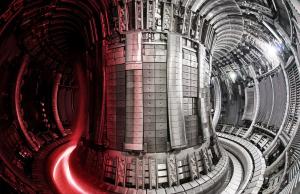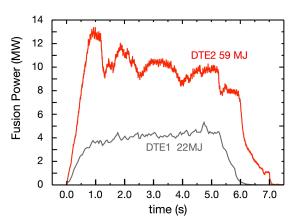JET makes history, again
The JET tokamak has achieved a first-ever sustained, high-confinement plasma using the same wall materials and fuel mix that ITER will use. The results aligned with prediction ... and this predictability is very good news for the ITER research program and for fusion in general.
JET—the Joint European Torus*, used by 4,800 EUROfusion consortium experts, students and staff from across Europe—has set a world record for the most energy produced in a single fusion shot, generating 59 megajoules** of heat from fusion reactions in a sustained manner. Results were announced on 9 February 2022 during a media event that can be watched in replay at this address.
The shot was part of a unique experimental campaign run in the last quarter of 2021 on JET, which introduced the high-performance fuel mix of deuterium (D) and tritium (T) for only the second time in the device's history. The heavy hydrogen isotopes deuterium and tritium fuse at temperatures that scientists and engineers can reach in a fusion installation (between 100 million and 200 million degrees Celsius), making them the most promising "ingredients" for ITER and future fusion power plants.
Deuterium-tritium (D-T) fuel has already produced some of the most spectacular records in fusion research. In 1991, the JET tokamak became the first experiment in the world to run a D-T experiment, obtaining close to 2 MW of fusion power in a 2s pulse with a 10 percent tritium mix. Two years later, the Tokamak Test Fusion Reactor (TFTR) in the United States used 50/50 D-T mix to achieve 6.2 MW of fusion power, followed shortly by a record-setting 10.7 MW pulse in 1994. JET vaulted to its own record of 16 MW of peak fusion power in 1997, but even more important during that historic campaign were the more sustained 5-second ~4.5 MW stationary shots in high-confinement mode (H-mode) with a total fusion energy production of 22 MJ. A "transient" plasma regime is nowhere near as valuable as stable, sustained regimes to researchers; this is also the type of value that will be sought in the operation of ITER and the design of future fusion demonstration power plants. In fact JET's "stable" results were used to establish the design basis for ITER.
The JET team knew it could go further. Not in terms of pulse duration but in terms of total fusion energy. (JET's copper electromagnets are not superconducting and will overheat if a high-energy plasma is maintained for more than 5 seconds). The 1997 experiments had provided valuable data about the behaviour of D-T fuel—most notably that tritium fuel was too easily trapped in the carbon inner wall of the vessel. "We undertook a major engineering project to change the whole of the inside of the wall of JET—that's 16,000 components, 4,000 tonnes of metal, and all of that was done using some of the most sophisticated robots on the planet," related Ian Chapman, CEO of the United Kingdom Atomic Energy Authority, during the media event.
Other upgrades included increasing installed plasma heating capacity from 24 MW to nearly 40 MW and upgrading measurement and control systems. JET was now ITER's "nearest neighbor" with the unique capability of achieving fusion conditions that are as close as possible to those expected on ITER.
When the team first operated with this new mixture of metals on the inside of the wall, however, performance fell short of expectations. It was "off the line" of where it needed to be to prove that ITER could meet its goals because the new metal materials were impacting the plasma in unforeseen ways. "Through perseverance, through ingenuity, through invention our scientists and our engineers found ways to recover, and we recovered the fusion performance," says Chapman.
JET was ready for a new rendezvous with D-T fuel.

The goal, this time, wasn't to surpass the peak fusion power of 1997 but to improve on the sustained fusion energy results.
The record shot was performed on 21 December 2021 at 14:30 CET (see the GIF video at right). Pulse #99971 achieved total fusion energy of 59 MJ—more than doubling the 1997 record. It maintained an even 10 MW of fusion power, also doubling the previous record, for 5 seconds. The plasma was tritium rich, consuming about 0.1 mg of tritium for 0.07 mg of deuterium. (For comparison: to release the same 59 MJ with fossil fuels, you'd need to burn more than a kilogram of natural gas or two kilograms of coal.)
"A sustained pulse of deuterium-tritium fusion at this power level—nearly industrial scale—delivers a resounding confirmation to all of those involved in the global fusion quest," said ITER Director-General Bernard Bigot. "For the ITER Project, the JET results are a strong confidence builder that we are on the right track as we move forward toward demonstrating full fusion power."
The results confirm that sustained high-fusion energy production is achievable using the D-T fuel mix planned on ITER and future devices. They also show that the fusion community has the capability to model what will happen in a fusion reactor.
"The result isn't a surprise; it's actually in accordance with prediction," explained ITER's Chief Scientist Tim Luce during the event. "And this is a fundamental result—that fusion is predictable. This will help us. When you talk about timeline—if fusion is predictable then we can optimize without having to do it by proving, in some sense. We can find our way more effectively. These results from JET give us a step up and a step ahead."
See the EUROfusion press release here.
*JET (the Joint European Torus) has been operated at the Culham Centre for Fusion Energy as a Joint Undertaking of the European Community since 1977, and operated under UKAEA since 2000. The Euratom Research and Training program has continuously contributed approximately 80 percent of JET operation costs through 2021.
**JET produced a total of 59 megajoules of heat energy from fusion over a five-second period. During the experiment, JET averaged a fusion power (i.e., energy per second) of around 11 megawatts. Megawatts are megajoules per second.



